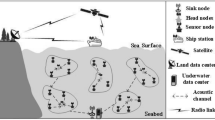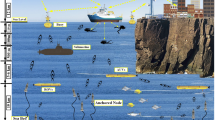Abstract
Underwater wireless sensor network transmission leads to higher energy consumption due to propagation distance and high energy loss. Moreover, the acoustic medium of acoustic animals and shadow affects the transmission between the source node and destination node. Some demerits of underwater communication are multipath fading, high path loss, frequent packet drops, limited bandwidth, salinity, pressure, temperature, sink hole and curved paths. These factors affect the network lifetime, packet delivery ratio (PDR), link quality and energy. To overcome these problems, Multilayer Clustering-based Butterfly Optimization Routing (MCBOR) algorithm has been introduced to deliver the data packets to the destination without any loss using the sense of butterflies. The proposed work aims to increase PDR and reduce transmission loss. The performance of the proposed MCBOR is evaluated by comparing its performance with state-of-the-art methods. Based on the evaluation report, the proposed MCBOR gives a packet delivery ratio of 0.98%, end to end delay of 6.3 s, and residual energy of 0.47 J. Thus, MCBOR is proved to be more efficient in PDR and reduces transmission loss.







Similar content being viewed by others
Abbreviations
- \(E_{t}\) :
-
Residual Energy
- \(T_{E}\) :
-
Threshold Residual Energy
- \(D_{\min }\) :
-
Sink and the closest node distance
- x:
-
Coefficient of distance associated with \(D_{\min }\) and D
- t:
-
Layer index
- \({E}_{0}^{2}\) :
-
Nodes radius
- \({E}_{t}\) :
-
Energy used for sending data
- \({E}_{r}\) :
-
Energy used for receiving the data
- \(R({B}_{i})\) :
-
Node’s radius in the network
- \(l_{r}\) :
-
Node
- \(L_{r}\) :
-
Neighbor nodes number of \(l_{r}\)
- \(\overline{{D(l_{r} }} )\) :
-
Distance sum between \(l_{r}\) and neighbor nodes
- \(d(l_{r} ,S)\) :
-
Distance from \(l_{r}\) to SN
- a(f):
-
Coefficient of absorption
- \(g_{CH}\) :
-
Prearranged CH competition time
- \(fi_{(Lq)}\) :
-
Link quality
- \((Pa_{(Rr)} )\) :
-
Packet reception rate
- \((pa_{(s)} )\) :
-
Total number of sent packets
- \((Bi_{(Er)}\) :
-
Bit error rate
- dt:
-
Node
- \(N_{L}\) :
-
Noise loss
- SL:
-
Source level
- \(B_{0}\) :
-
Normalizing constant
- \(D_{sd}\) :
-
Distance between source and destination
- \((Depth_{cur\,nei} )\) :
-
Depth difference between the current node and neighbor node
- f:
-
Perceived odor of butterflies
- A:
-
Power exponent in need of fragrance
- v:
-
Solution vector \(x_{q}^{v}\)
- R:
-
Random number
- \(x_{k}^{v}\) and \(x_{j}^{v}\) :
-
Kth and jth butterflies from the solution space
- \(p_{t}\) :
-
Width of the t-th layer
- \(R_{\max }\) :
-
Maximum competition radius of the CH
- D:
-
Distance between sink node S and the farthest node from it
- k:
-
Number of layers
- \({E}_{avg}^{2}\) :
-
Average distance between neighbor and node
- \({E}_{RE}\) :
-
Total energy of node
- \({E}_{a}\) :
-
Energy used for aggregating data
- \({E}_{c}\) :
-
Energy used for the collection of data
- \(V_{{(l_{r} )}}\) :
-
Weight value
- \(E(l_{r} )\) :
-
RE of \(l_{r}\)
- \(\overline{{E(L_{r} }} )\) :
-
Average RE of neighbor nodes of \(l_{r}\)
- \(R_{\max } (l_{r} )\) :
-
Maximum radius of \(l_{r}\)
- \(TL_{loss} (u)\) :
-
Transmission loss
- \(g(l_{r} )\) :
-
Hold time of a cluster
- \(\lambda\) :
-
Random number
- \((Pa_{(Er)} )\) :
-
Packet error rate
- \((pa_{(r)} )\) :
-
Received number of packets
- \((Si_{(Nr)} )\) :
-
Signal-to-noise ratio
- l:
-
Packet length
- \(P_{t}\) :
-
Transmitting power
- \(T_{L}\) :
-
Transmission loss
- \(S_{F}\) :
-
Spreading factor
- fq:
-
Frequency
- \({(\mathrm{fi}}_{\mathrm{ne CH}})\) :
-
Nearest to CH
- \(Depth_{nei\,CH}\) :
-
Depth difference between the neighbor node and CH.
- c:
-
Sensory modality
- \(x_{q}\) :
-
Q-th butterfly iteration number
- \(g *\) :
-
Current optimal solution found among all solutions in present iteration
- \(f_{q}\) :
-
Odor of q-th butterfly
References
Huang, B., Zhou, B., Zhang, S., & Zhu, C. (2021). Adaptive prescribed performance tracking control for underactuated autonomous underwater vehicles with input quantization. Ocean Engineering., 221, 108549.
Zhu, C., Huang, B., Zhou, B., Su, Y., & Zhang, E. (2021). Adaptive model-parameter-free fault-tolerant trajectory tracking control for autonomous underwater vehicles. ISA Transactions.
Ali, M. F., Jayakody, D. N., Chursin, Y. A., Affes, S., & Dmitry, S. (2020). Recent advances and future directions on underwater wireless communications. Archives of Computational Methods in Engineering., 27(5), 1379–1412.
Datta, A., & Dasgupta, M. (2021). On accurate localization of sensor nodes in underwater sensor networks: A Doppler shift and modified genetic algorithm based localization technique. Evolutionary Intelligence, 14(1), 119–131.
Omeke, K. G., Mollel, M. S., Ozturk, M., Ansari, S., Zhang, L., Abbasi, Q. H., & Imran, M. A. (2021). DEKCS: A dynamic clustering protocol to prolong underwater sensor networks. IEEE Sensors Journal, 21(7), 9457–9464.
Gupta, O., & Goyal, N. (2021). The evolution of data gathering static and mobility models in underwater wireless sensor networks: A survey. Journal of Ambient Intelligence and Humanized Computing., 3, 1–7.
Luo, J., Chen, Y., Wu, M., & Yang, Y. (2021). A survey of routing protocols for underwater wireless sensor networks. IEEE Communications Surveys & Tutorials., 23(1), 137–160.
Khisa, S., & Moh, S. (2021). Survey on recent advancements in energy-efficient routing protocols for underwater wireless sensor networks. IEEE Access., 7(9), 55045–55062.
Thalore, R., Vyas, V., Sharma, J., & Raina, V. (2021). Utilizing artificial intelligence to design delay and energy-aware wireless sensor networks. In Artificial intelligence and global society (pp. 229–250). Chapman and Hall/CRC.
Gupta, V., & De S. (2021). Energy-efficient edge computing framework for decentralized sensing in WSN-assisted IoT. IEEE Transactions on Wireless Communications.
Javaid, N., Shakeel, U., Ahmad, A., Alrajeh, N., Khan, Z. A., & Guizani, N. (2019). DRADS: Depth and reliability aware delay sensitive cooperative routing for underwater wireless sensor networks. Wireless Networks, 25(2), 777–789.
Khan, Z. A., Awais, M., Alghamdi, T. A., Khalid, A., Fatima, A., Akbar, M., & Javaid, N. (2019). Region aware proactive routing approaches exploiting energy efficient paths for void hole avoidance in underwater WSNs. IEEE Access, 7, 140703–140722.
Wang, S., Nguyen, T. L., & Shin, Y. (2019). Energy-efficient clustering algorithm for magnetic induction-based underwater wireless sensor networks. IEEE Access, 7, 5975–5983.
Bhattacharjya, K., Alam, S., & De, D. (2019). CUWSN: energy efficient routing protocol selection for cluster based underwater wireless sensor network. Microsystem Technologies, 1–17.
Awais, M., Khan, Z. A., Javaid, N., Mateen, A., Rasul, A., & Hassan, F. (2019). Cluster-based routing protocols with adaptive transmission range adjustment in UWSNs. In International Conference on Emerging Internetworking, Data & Web Technologies (pp. 528–539). Springer.
Anuradha, D., & Srivatsa, S. K. (2019). Energy effectual reconfigurable routing protocol (E2R2P) for cluster based underwater wireless sensor networks. Journal of Ambient Intelligence and Humanized Computing, 1–8.
Wang, M., Chen, Y., Sun, X., Xiao, F., & Xu, X. (2020). Node energy consumption balanced multi-hop transmission for underwater acoustic sensor networks based on clustering algorithm. IEEE Access, 19(8), 191231–191241.
Kumari, S., Mishra, P. K., & Anand, V. (2020). Fault resilient routing based on moth flame optimization scheme for underwater wireless sensor networks. Wireless Networks, 26(2), 1417–1431.
Fang, Z., Wang, J., Jiang, C., Zhang, B., Qin, C., & Ren, Y. (2020). QLACO: Q-learning aided ant colony routing protocol for underwater acoustic sensor networks. In 2020 IEEE wireless communications and networking conference (WCNC) (pp. 1–6). IEEE.
Banaeizadeh, F., & Haghighat, A. T. (2020). An energy-efficient data gathering scheme in underwater wireless sensor networks using a mobile sink. International Journal of Information Technology, 12(2), 513–522.
Ismail, M., Islam, M., Ahmad, I., Khan, F. A., Qazi, A. B., Khan, Z. H., & Al-Rakhami, M. (2020). Reliable path selection and opportunistic routing protocol for underwater wireless sensor networks. IEEE Access, 8, 100346–100364.
Zhu, J., Du, X., Han, D., Wang, L., & Li, M. (2019). LEER: Layer-based and energy-efficient routing protocol for underwater sensor networks. In International conference on ad hoc networks (pp. 26–39). Springer.
Kumari, S, Mishra, P. K, Anand, V. (2020) Integrated Load Balancing and Void Healing Routing with Cuckoo Search Optimization Scheme for Underwater Wireless Sensor Networks. Wireless Personal Communications, 111(3):1787–803.
Priyadarshini, R. R., & Sivakumar, N. (2019). Enhancing coverage and connectivity using energy prediction method in underwater acoustic WSN. Journal of Ambient Intelligence and Humanized Computing, 5, 1.
Khan, W., Hua, W., Ayaz, M., Anwar, M. S., & Ahmad, S. (2019) A balanced energy efficient (BEE) routing scheme for underwater WSNs. In International conference on innovative mobile and internet services in ubiquitous computing (pp. 82–93). Springer.
Funding
None.
Author information
Authors and Affiliations
Contributions
All the authors have participated in writing the manuscript and have revised the final version. All authors read and approved the final manuscript.
Corresponding author
Ethics declarations
Conflict of interest
The authors declares that they have no conflict of interest.
Ethical approval
This article does not contain any studies with human participants and/or animals performed by any of the authors.
Informed consent
There is no informed consent for this study.
Additional information
Publisher's Note
Springer Nature remains neutral with regard to jurisdictional claims in published maps and institutional affiliations.
Rights and permissions
About this article
Cite this article
Chenthil, T.R., Jesu Jayarin, P. An Energy-Aware Multilayer Clustering-Based Butterfly Optimization Routing for Underwater Wireless Sensor Networks. Wireless Pers Commun 122, 3105–3125 (2022). https://doi.org/10.1007/s11277-021-09042-6
Accepted:
Published:
Issue Date:
DOI: https://doi.org/10.1007/s11277-021-09042-6




